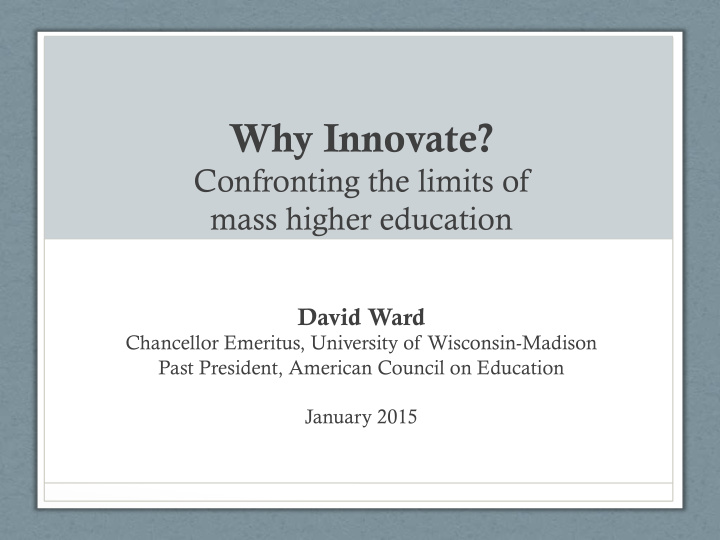



Why Innovate? Confronting the limits of mass higher education David Ward Chancellor Emeritus, University of Wisconsin-Madison Past President, American Council on Education January 2015
Current Issues • Squeezed between high expectations and systemic vulnerabilities • Tensions between past traditions and the digital revolution • Tensions are grounded in the outmoded assumptions about mass HE • Innovation may need to question these assumptions • Educational values, as well as cost, must drive innovation
Expectations • Competitive asset in the global knowledge economy • Insistence on high accessibility • Shift in balance of existential and utilitarian roles • Balance of public and individual share of cost
Vulnerabilities • Diminished or stable public investments • Inflationary costs and rising student debt – doubts about the value proposition • Concerns about performance – efficiency and quality – accountability • Curricula and program priorities – cost of comprehensiveness • Global dialogue with national and regional magnitudes
Global Dialogue But U.S. Often a Key Benchmark • First example of mass HE – idealism of post WW2 • Low cost – High Access – Uniform Mission • Integrated Mission – 4 year undergraduate residential program • National Research Funding despite limited federal scope • First to reach the fiscal limits of mass HE • Anxieties about quality – paradox of precocity and mediocrity
New Era and New Outcomes • Need-based differential tuition – loans rather than grants • Student demographics • Mission Variability • Concentration of Funded Research and Philanthropy • Alternative Providers • Misfits of policy and practice – Standardization v Customization
Restrained Institutional Responses • “Let the pendulum swing” or “is the pin lost?” • Focus on a revenue crisis • Limits of current cost containment • Legitimacy narrowly defined – multiple stakeholders • Highly decentralized elaborate decision-making • Nevertheless major innovations at individual or group level
Need to Respond at Scale • Define mission niche and institutional partnerships • Redefine the meanings and proportions of tripartite missions • Simplify the academic division of labor • Provide hybrid pedagogies at scale • Customize time to degree, timetable and examinations • Create structured student pathways • Promote collaborative and integrative research • Integrate infra-structure • Implications for future physical environments of HE
Recapitulation • Confusion of future visions and past virtues • Mid-20 th Century Model designed for 25% of student age cohort • Past virtues still relevant for this 25% • Cannot serve the remaining 75% without redesign • Redesign at scale justified by educational motives • Execution needs a vision and a plan
The Pendulum in Off Its Pin. It’s Time to Innovate
Recommend
More recommend